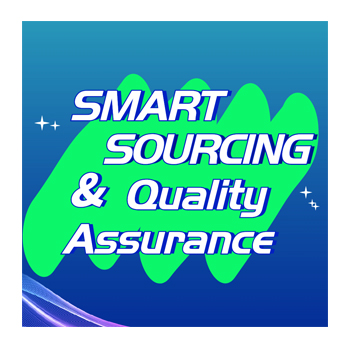
In the rapidly changing business environment, innovative sourcing has become a key factor in driving enterprise efficiency, reducing costs, and enhancing competitiveness. Traditional procurement models often focus on cost control and supplier management, while innovative sourcing integrates the concepts of strategic thinking, technological innovation, and continuous improvement on this basis. This shift not only brings unprecedented opportunities, such as optimizing procurement processes through intelligent tools and enhancing decision-making quality through big data analysis, but also poses challenges, such as how to effectively integrate new technologies and balance innovation with risk. This guide aims to provide procurement professionals with a comprehensive framework to deeply understand and grasp the core elements of innovative sourcing, laying a solid foundation for the long-term development of enterprises.
Understand innovative sourcing
What is innovative sourcing?
Innovative sourcing represents a cutting-edge practice in the procurement field, which transcends the boundaries of traditional procurement. It not only focuses on price and transaction terms, but also views procurement as a strategic business process. This approach integrates the latest technologies, advanced management concepts, and innovative process design to comprehensively optimize the entire procurement cycle, from demand generation to supplier selection, contract signing, as well as subsequent performance evaluation and relationship management. Its core objective is to maximize cost-effectiveness while enhancing the flexibility and sustainability of the supply chain, ensuring that enterprises can maintain competitiveness in a rapidly changing market environment.
Why is it important in innovative sourcing?
The importance of innovative sourcing is manifested in multiple aspects. Firstly, it enables enterprises to respond to market changes more quickly, adapting swiftly to new market demands and supply conditions through flexible sourcing strategies and efficient process adjustments. Secondly, innovative sourcing effectively reduces procurement costs and improves capital utilization efficiency by introducing competition mechanisms and technological innovations. Furthermore, it fosters deeper cooperation with suppliers, going beyond mere transactions of goods and services, to jointly explore the development of new products, technologies, and services, thereby enhancing the innovation capability and market competitiveness of the entire supply chain. Ultimately, these advantages collectively contribute to improving the overall operational efficiency and long-term profitability of enterprises.
The key to innovative sourcing
Creativity and flexibility
One of the core principles of innovative sourcing is to encourage creativity and flexibility. This requires the procurement team to possess a mindset of breaking conventions and being brave enough to try new methods, constantly seeking better procurement solutions. Flexibility is reflected in the ability to quickly adjust procurement strategies based on market changes, internal corporate needs, and changes in supplier capabilities, ensuring that procurement activities always align with corporate strategy.
Technology integration
Another key principle is the effective integration of technology. With the rapid development of information technology, tools such as electronic procurement platforms, artificial intelligence, and big data analysis provide unprecedented support for procurement activities. The application of these technologies can greatly enhance procurement efficiency, reduce human errors, and provide deeper data insights, helping procurement teams make more informed decisions. Therefore, innovative sourcing emphasizes seamlessly integrating these advanced technologies into the procurement process to achieve the intelligence and automation of procurement activities.
Master the steps of innovative sourcing
Identify needs and opportunities
Analyze the current procurement process
The first step to mastering innovative sourcing is to conduct an in-depth analysis and evaluation of the existing procurement process. This includes the entire procurement cycle from demand proposal to supplier selection, contract signing, goods receipt, payment, and subsequent performance evaluation. Key review areas include the stability of supplier performance, the efficiency of contract management processes, and the reasonableness of cost structures. Through this step, bottlenecks and inefficient links in the procurement process can be identified, providing direction for subsequent innovative improvements.
Discover innovative sourcing areas
Based on the analysis of the current procurement process, the next step is to identify areas that can be improved through innovative sourcing. This may involve various aspects of the procurement process, such as using automated tools to reduce human errors, optimizing inventory management through data analysis, and adopting electronic bidding systems to enhance procurement transparency. Innovation is not limited to technology application, but also includes innovations in process optimization, supplier relationship management, and other aspects.
Develop a strategic plan for innovative sourcing
Set clear objectives for innovative sourcing
After identifying innovative opportunities, it is necessary to establish clear innovative sourcing goals. These goals should be aligned with the overall corporate strategy, such as reducing procurement costs, improving supplier response speed, and enhancing supply chain flexibility. Setting specific and measurable goals helps guide subsequent innovative sourcing activities and ensures that all efforts are focused on achieving these goals.
Align with organizational goals
An innovative sourcing plan must not only focus on procurement itself, but also ensure alignment with the long-term goals of the company. This includes financial objectives (such as cost savings), market positioning (such as supporting new product development through innovative sourcing), and social responsibility (such as green procurement). By ensuring that the innovative sourcing plan is consistent with the overall corporate strategy, the contribution of procurement activities to the overall corporate performance can be maximized.
Implement innovative solutions
Technology is the key to achieving innovative sourcing. Based on the previously identified areas of innovation, introduce suitable technological solutions such as electronic bidding systems, smart contracts, big data analysis, etc. These technologies can automate the procurement process, improve transparency and efficiency, while providing deeper data insights to support more informed decision-making.
The implementation of innovative sourcing requires cross-departmental collaboration and support from external suppliers. Establish close cooperative relationships with internal departments (such as finance and R&D) to ensure that the innovative sourcing plan receives sufficient resources and support. At the same time, establish long-term partnerships with external suppliers to jointly promote the implementation of innovative projects and achieve a win-win situation.
Monitoring and continuous improvement of innovative sourcing
To evaluate the effectiveness of innovative sourcing, it is necessary to establish key performance indicators (KPIs) and conduct regular monitoring. These indicators may include cost savings, efficiency improvement, supplier satisfaction, and reduction in procurement cycle time. Through regular evaluation, the actual effectiveness of the innovative sourcing plan can be understood, providing a basis for subsequent improvements.
The market environment and corporate needs are constantly changing, so the innovative sourcing plan also needs to be continuously adjusted and optimized. Based on monitoring results and market feedback, flexibly adjust procurement strategies to ensure that procurement activities always keep pace with corporate needs and market trends. This includes regularly reviewing the procurement process, evaluating the applicability of new technologies and methods, and adjusting the goals and priorities of innovative sourcing according to corporate needs.
Lessons learned from the application of innovative sourcing
Key points
Open communication: Establish an open communication mechanism with suppliers to ensure both parties can share information, solve problems, and jointly respond to market changes in a timely manner.
Joint goal setting: Set clear and measurable goals with suppliers to ensure that both parties are working towards the same direction.
The appropriateness of technology application: Based on the actual situation and needs of the enterprise, select suitable technology solutions, and ensure the effective integration and application of technology.
Common pitfalls to avoid
Improper technology selection: When introducing new technologies, it is necessary to fully consider the maturity, applicability, and cost-effectiveness of the technology, avoiding blindly following trends or choosing technologies that are not suitable for the actual needs of the enterprise.
Internal resistance: Innovative sourcing often involves changes in organizational structure and processes, which may encounter resistance from internal employees. Therefore, it is necessary to conduct internal communication and training in advance to ensure that employees understand and support innovative sourcing.
Lack of continuous monitoring: Innovative sourcing is a continuous process that requires the establishment of an effective monitoring mechanism to evaluate the effectiveness and adjust strategies in a timely manner. The lack of continuous monitoring may lead to the loss of control or poor results in innovative sourcing activities. To address this challenge, companies should regularly review the procurement process, assess the applicability of new technologies and methods, and adjust the goals and priorities of innovative sourcing according to actual needs.
Future trends of innovative sourcing
Emerging technologies
With the continuous development of artificial intelligence (AI) and machine learning (ML) technologies, their potential for application in the procurement field is increasingly prominent. AI and ML can be used to predict demand, analyze historical data and market trends, and more accurately forecast future procurement needs, thereby helping enterprises optimize inventory management and reduce excess inventory. In addition, these technologies can also automate the contract review process, quickly identifying risk points and non-compliant clauses in contracts through intelligent algorithms, improving the efficiency and accuracy of contract management.
Blockchain technology, with its unique decentralization, immutability, and traceability features, has brought new opportunities to the field of procurement. Through blockchain, enterprises can build a more transparent and credible supply chain system. Blockchain can record all transaction information throughout the entire process from raw material procurement to product delivery, ensuring the authenticity and integrity of data. This helps simplify the transaction process, reduce fraudulent behavior, and enhance the traceability of the supply chain. At the same time, blockchain can also enhance data security, protecting sensitive information of enterprises and suppliers from being leaked.
Evolving market dynamics
The impact of globalization on innovative sourcing
In the context of globalization, procurement activities have transcended national boundaries, involving suppliers from different cultures and regions. This requires enterprises to pay more attention to cross-cultural communication and multinational supply chain management during the innovative sourcing process. Enterprises need to establish effective communication mechanisms to ensure smooth exchanges with suppliers from different cultural backgrounds and understand each other's needs and expectations. At the same time, enterprises also need to have a global perspective, understand the laws, regulations, and business practices in different regions, to ensure the compliance and efficiency of procurement activities.
Sustainability considerations
With the increasing attention of society on environmental protection, social responsibility, and economic sustainability, innovative sourcing also needs to take these factors into consideration. Green procurement strategies have become the choice of more and more enterprises. By choosing environmentally friendly materials, supporting suppliers with sustainable production, and optimizing logistics methods, enterprises can reduce the environmental impact of procurement activities while enhancing their brand image and social responsibility. In addition, green procurement can also promote collaborative innovation between enterprises and suppliers, jointly developing more environmentally friendly and sustainable products and services.
Common problems in innovative sourcing
1.How to start with innovative sourcing?
Starting an innovative sourcing project requires a series of orderly steps to ensure success. Firstly, the company should establish an inter-departmental innovative sourcing team, which should include key members from multiple departments such as procurement, finance, research and development, and operations, to ensure multi-angle consideration and collaboration. Next, conduct preliminary training to enhance team members' understanding of innovative sourcing concepts, methods, and tools.
Identifying pilot projects is a crucial step. Selecting one or several representative procurement processes or products as pilot projects can be small-scale projects, allowing for the testing of new methods and technologies while controlling risks. Through pilot projects, companies can accumulate practical experience, identify problems, and gradually optimize the procurement process.
2. What risks are involved?
Innovative sourcing may face various risks. Technical implementation failure is a common risk, especially when companies try to introduce new technologies that have not been fully verified. To reduce this risk, companies should conduct thorough market research and technology assessment, choose mature and reliable technology solutions, and implement them in stages.
Unstable supplier cooperation is also a risk that may be encountered in innovative sourcing. To reduce this risk, enterprises should establish stable supplier relationships, enhance supplier loyalty and willingness to cooperate through long-term cooperation agreements, joint goal setting, and regular communication. At the same time, enterprises should also establish a diversified supplier network to reduce dependence on a single supplier.
Risk management strategies include establishing risk identification and assessment mechanisms, regularly monitoring and evaluating potential risks in innovative sourcing projects, and formulating corresponding response measures. In addition, enterprises should also establish a flexible project adjustment mechanism to enable timely strategy adjustments in case of risks, ensuring the smooth progress of the project.
How to understand innovative sourcing?
The successful cases and best practices of industry-leading enterprises provide useful references for innovative sourcing. Continuous learning mechanism is one of the keys. Enterprises should encourage procurement professionals to constantly learn new knowledge and skills to keep up with market and technological changes. This can be achieved by participating in industry training, seminars, online courses, and other means.
To assist procurement professionals in continuously enhancing their capabilities and knowledge, here are some recommended resources for further learning:
- Books: Choose classic books related to procurement, supply chain management, and innovative management, such as "Procurement and Supply Chain Management" and "The Innovator's Dilemma", to gain a deep understanding of related theories and practices.
- Online courses: Utilize online learning platforms such as MOOCs, Netease Cloud Classroom, etc., to participate in online courses related to procurement and supply chain management, and learn the latest knowledge and skills.
- Industry forums: Participate in forums, seminars, and networking events within the industry, exchange experiences with peers, and stay informed about the latest developments and trends in the industry.
- Professional associations: Join professional associations or organizations related to procurement and supply chain management, such as the China Federation of Logistics and Purchasing, to obtain industry information, participate in training activities, and expand networking resources.
This guide provides a comprehensive guidance framework for procurement professionals by delving into the definition, principles, implementation steps, future trends, as well as the challenges and solutions faced by innovative sourcing. Mastering innovative sourcing is the key to addressing current market challenges and an important way to drive the continuous growth and competitive advantage of enterprises. We encourage every procurement professional to actively embrace innovation, constantly learn new knowledge, adapt to new technologies, and drive the transformation and upgrading of procurement activities with innovation, creating greater value for the enterprise.

Smart Sourcing Content Team
Article by Smart Sourcing Content Team
The Smart Sourcing Content Team is committed to delivering high-quality, easy-to-understand information that helps our audience navigate the complexities of global sourcing. Our team of writers has extensive experience in producing articles across various fields such as procurement, supply chain management, market trends, and industry best practices. We specialize in sectors like apparel, textiles, and consumer goods, providing targeted insights to help businesses in these industries optimize their sourcing strategies and stay competitive.
Grow your business with TradeAider Service
Click the button below to directly enter the TradeAider Service System. The simple steps from booking and payment to receiving reports are easy to operate.



